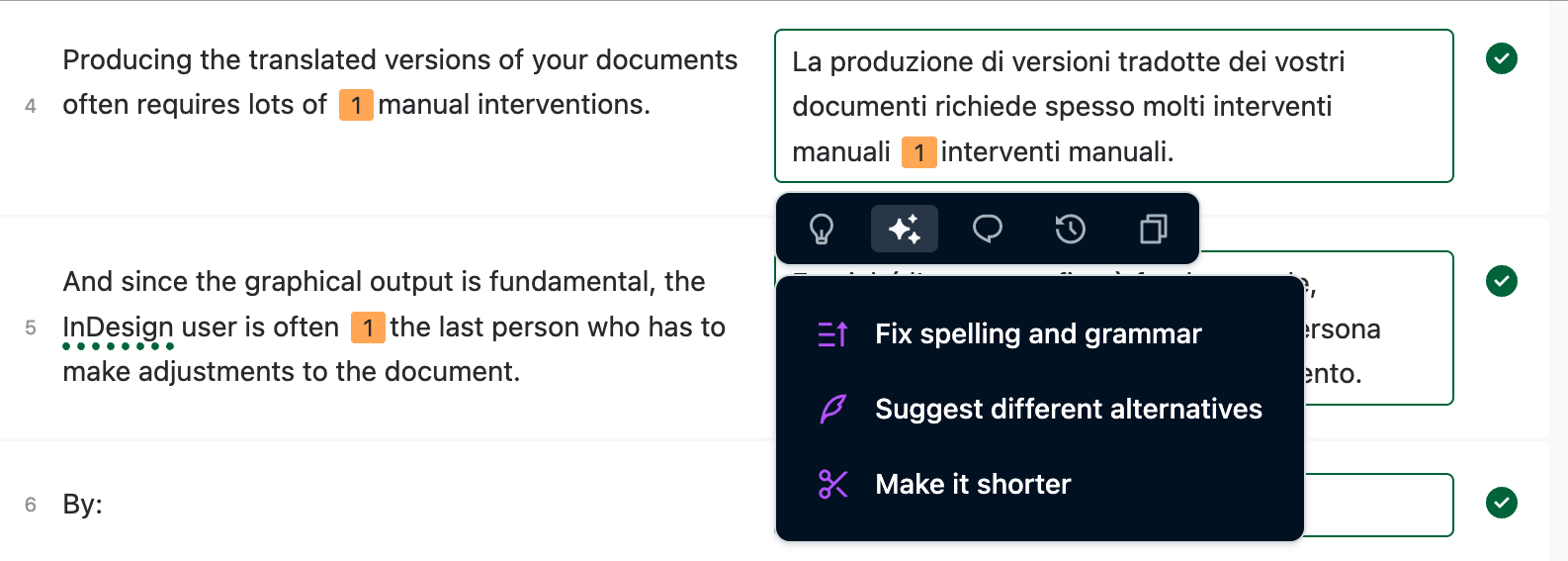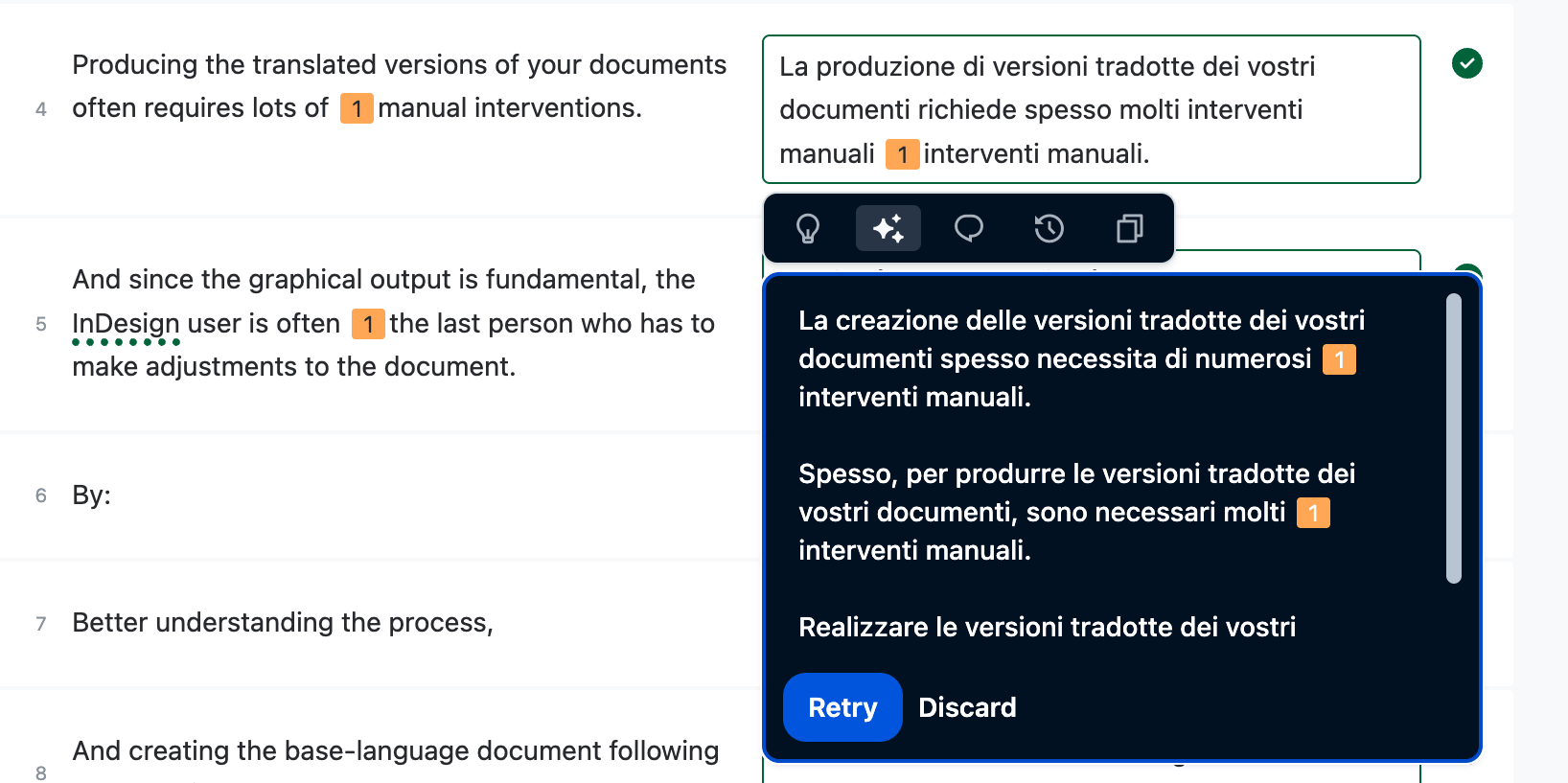🚀 How to use the Web Editor
The Web Editor is where you translate documents in Redokun.
You can type your translations manually or refine suggestions from Translation Memory and AI.
Whether you're working alone or with others, this tool helps you stay focused, keep consistency, and collaborate in real time.
✍️ Translating Segments
To translate a segment:
- Click on the translation box next to the source segment.
- Type your translation directly into the box.
- If you see formatting elements like colored numbers or blue labels, those are tags and markers. Use the
Tabkey to insert them. You’ll learn more about this later in this guide. - Press
Returnto move to the next segment. - Redokun automatically saves your translation progress.

💡 Utilizing Translation Suggestions
Redokun offers suggestions to expedite your translation process:
- Translation Memory (TM) Suggestions: Previously approved translations are suggested when similar segments are detected.
- AI Suggestions: Leverage integrated AI engines like Google Translate or DeepL for initial drafts.
To apply a suggestion:
- Click on the desired suggestion below the translation box.
- Edit the text if necessary.
- Press
Returnto confirm and proceed.

🏷️ Formatting Placeholders: What Are Tags and Markers (and What Should You Do with Them?)
Redokun uses tags and markers to preserve formatting and special characters in your translated documents.
🔖 Tags
- Purpose: Tags indicate formatting elements such as bold, italics, underlines, colors, and hyperlinks.
- Appearance: Displayed as numbered placeholders (e.g.,
1,2) within the Web Editor. - Best Practices:
- Ensure all tags from the source segment are present in the translation to maintain formatting integrity.
- To insert a tag, place your cursor at the desired location in the translation box and press the
Tabkey. - If a tag is misplaced, delete it, reposition your cursor, and press
Tabto reinsert.
🕵️ Markers
- Purpose: Markers represent special characters like soft returns or non-breaking spaces.
- Appearance: Shown as blue placeholders with descriptive labels (e.g.,
[soft return]). - Usage:
- Markers are optional; include them in your translation only if they are present in the source segment and relevant to the context.
- To reduce or eliminate markers, you can enable the following options in Settings > Advanced Settings:
- Convert Soft-returns: Standardizes soft line breaks.
- Convert Special Spaces: Replaces non-breaking or special spaces with standard spaces.
For a comprehensive guide on handling tags and markers, please refer to our Tags and Markers Help Center article.
✅ Confirming Translations
When you're happy with a translation, click Confirm Translation to mark the segment as completed.
This saves the translation to your Translation Memory so it can be reused in future projects.

✨ Use AI Fine-Tuning
The AI Fine-Tuning helps you:
- Improve quality quickly – Correct grammar and spelling in seconds.
- Find the right tone – Explore different alternatives to match your style.
- Fix layout issues – Shorten text to avoid design problems in languages like German.
To use it:
Click the ✨ Fine-tune button next to any segment.

Choose one of the refinement options:
- Fix spelling and grammar – Corrects grammatical issues and typos while ensuring proper sentence structure.
- Suggest different alternatives – Offers alternative phrasings so you can choose the best fit.
- Make it shorter – Condenses the translation while preserving key information.
Review the AI’s suggestion. Use it as is, or retry for a different suggestion until you find the best fit. The result will be copied into the translation box, where you can edit it further if necessary.

For more information, see the full guide: AI Fine-Tuning.
🏁 Complete the Translation Job
Once you’ve translated the full document, you have two options:
- Leave a comment under Brief, notes and instructions: Use this to let the team know you’ve finished and someone else should review or take over.
- Click Confirm Translation: this informs the document owner that the translation is complete.
⚠️ Once confirmed, the document is locked. Translators will no longer be able to make edits. If changes are needed later, click Ask to unlock translation to request the document owner’s action. Only the document owner can unlock it.
🔓 Unlocking a Confirmed Translation
Once you’ve completed and confirmed a translation, the document becomes locked to prevent unintended edits. If you need to make further changes:
- Navigate to the target language in the Web Editor.
- Click on “Ask to unlock translation” at the top right corner.
- This sends a request to the document owner or manager to unlock the translation.
Alternatively, use the “Brief, notes and instructions” panel to communicate with your team and request an unlock.

🧑🤝🧑 Collaborating in the Web Editor
Redokun's Web Editor includes built-in collaboration tools that help teams stay aligned and move faster—without extra meetings or long email threads.
Key collaboration features:
- Brief, notes, and instructions: Add context or clarify roles for your team (e.g., who translates or reviews).
- Segment comments: Discuss specific translations, clarify terminology, or flag issues directly next to a segment.
- Mentions: Tag a teammate in a comment using '@' to draw their attention.
- Simultaneous editing: More than one person can translate or review the same document in real time.
🔗 Learn more about comments, mentions, and notifications →

🔍 Searching and Filtering Segments
To efficiently navigate through segments:
- Show Filter: Display specific segment types (e.g., untranslated, drafts, commented).
- Search in Source: Find specific words or phrases in the source text.
- Search in Translation: Locate particular terms within your translations.
✅ Tip: Combine filters and search functions to quickly navigate large documents.

⚡ Launch Pre-Translate from the Web Editor
If your document hasn’t been entirely translated yet, you can launch Pre-Translate directly from inside the Web Editor:
- Click Pre-Translate in the top menu.
- Choose your preferred translation options.
- Click Launch Pre-translation to automatically fill in translations using Translation Memory and AI (as draft translations).
Learn more in the Pre-Translate user guide →

💬 Common Questions in the Web Editor
👥 Can more than one translator work on the same document?
Yes! Redokun allows multiple translators to work on the same document at the same time.
When one person selects a translation box, that segment is temporarily locked for others, and you’ll see who is working on it.
🔽 Can I jump to the first empty translation box?
Yes. Click the down arrow next to the Show filter to automatically jump to the first empty segment.

💾 How do I save a translation?
You don’t have to! Translations are saved automatically as you type, so you never lose your progress.
📝 Can I mark a translation as a draft?
Yes. Just click the status icon inside the translation box to mark the translation as a draft.
❓ What happens if I leave a translation box empty?
If you leave a translation box empty, Redokun will exclude that segment from the final document—meaning the original source text will be removed.

